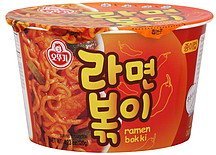Product pictures
| Amount Per 2.12 oz, 60 g | |||
| Calories | 240 Kcal (1005 kJ) | ||
| Calories from fat | 63 Kcal | ||
| % Daily Value* | |||
| Total Fat | 7g | 11% | |
|---|---|---|---|
| Saturated Fat | 4g | 20% | |
| Sodium | 670mg | 28% | |
| Total Carbs | 39g | 13% | |
| Sugars | 6g | 24% | |
| Dietary Fiber | 2g | 8% | |
| Protein | 4g | 8% | |
* Percent Daily Values are based on a 2000 calorie diet. Your daily values may be higher or lower depending on your calorie needs.
Find out how many calories should you eat.
Ingredients And Nutrition Overview
Best
choice Good
choice Poor
choice Avoid
it!
choice Good
choice Poor
choice Avoid
it!
-
WeightWatchers Points: 5, PointsPlus: 6, SmartPoints: 9
WeightWatchers Points are estimated by carbohydrates, fats, protein and fiber in product. They are not an affirmation of better quality or nutritional value of the product or its manufacturer. Only way to count for dieters. Less points are better.
Read more at Weight watchers diet review -
Over 20% of daily saturated fat!
Bad! More 20% of daily saturated fat!
For years Saturated fat was claimed to raise cholesterol levels and give us heart attacks. Today different studies refute this claim. They say, that replacing saturated fat with carbohydrates or refined starch or sugar is not changing the heart disease risk. Not processed carbs nor saturated fats are good for you. Only if you replace it with polyunsaturated fat, you'll get a reduction in heart disease risk. So try to have a balanced diet. -
Salty! Has over 28% of the daily sodium max
The average American consumes 5,000 mg of sodium daily — twice the recommended amount amount of 2400mg for healthy adults, this is 1 teaspoon of salt.
For medical reasons many people should not exceed 1500mg of sodium.
Surprisingly, you're responsible for only 15% of the sodium in your diet the bigger part - 75% of the sodium that you consume each day comes from processed foods, not home cooking or the salt shaker.
Excess sodium intake increases the risk of high blood pressure, hypernatremia, hypertension, cardiovascular disease and other heart problems.
Are these reasons enough to cut the sodium intake? No doubt! -
Convert Salt tsps to Sodium mg easily
Salt (NaCl) is not excactly sodium (Na).
It is not right to use these terms as synonyms.
The FDA recommended limit of sodium is 2,300 mg per day (or even less - about 1500 mg while one is on low sodium diets).
This is much less than the weight of salt.
(5,750 mg per day or 3,750 mg for low sodium diet) and not so convenient to calculate.
Know how much sodium is in your salt - without a calculator:
1/4 tsp salt = 600 mg sodium
1/2 tsp salt = 1200 mg sodium
3/4 tsp salt = 1800 mg sodium
1 tsp salt = 2300 mg sodium -
2 tsp of sugars per serving
This volume includes both naturally occurring from ingredients and specially added sugars.
USDA tells us that last years each American consumed an average 130 pounds of caloric sweeteners per year!
That works out to 30 tsp of sugars per day approximately 480 extra calories!
Just to think: Eating just 200 more calories daily than your body requires for body functioning and exercise leads to a 20-pound weight gain in a year. -
More than 8% daily fiber!
Eat more fiber. You've heard it many times. But why it is so good for your health?
Dietary fiber is best known for its ability to make our digestion going right.
So want to prevent or relieve constipation - eat more fiber!
There are also other great health benefits as well, such as lowering your risk of diabetes, heart disease and cancer, and helping to maintain a healthy weight by helping to feel you full longer.
The best source of fiber are fruits, vegetables, whole grains and legumes and not processed foods with added fiber. -
Contains MSG-like ingredients
People feeling reaction to MSG may also react adversely to MSG-like substances.
Glutamates or chemically similar items are added to improve a product's taste.
Here is a short list of common MSG-like substances:
- Yeast extract
- Autolyzed yeast
- Hydrolyzed proteins
- Textured proteins
- Anything "enzyme modified"
Allergens
Gluten Allergy, Wheat Allergy, Soy Allergy, Fish Allergy
Ramen bokki Ingredients
Noodle: Wheat Flour, Palm Oil, Potato Starch, Modified Potato Starch, Wheat Gluten, Salt, Emulsified Oil, Onion Extract, Alkaline Agent (Potassium Carbonate, Sodium Carbonate), Riboflavin. Liquid Soup: Red Pepper Paste, Sugar, Fructo Oligosaccharide, Onion, Water, Soy Sauce, Garlic, Beef Bone Extract, Salt, Roasted Onion Powder, Roasted Red Pepper Powder, Roasted Garlic Powder, Malic Acid, Glycine, Anchovy Extract Powder, 5-Inosinate, 5-Guanosine, Caramel Powder, Concentrated Red Pepper Sauce, Yeast Extract Powder, Succinic Acid, Black Pepper Powder. Dehydrated Vegetable Mix: Cabbage, Dried Green Onion, Dried Fish Paste.
You Might Also Like
% RDI of Main Nutrition Facts
12%
of RDI* (240 calories) 60 g
-
Cal: 12 %
-
Fat: 10.8 %
-
Carb: 13 %
-
Prot: 8 %
-
0%25%75%RDI norm*
Calories Breakdown
- Carbs (66.4%)
- Fat (26.8%)
- Protein (6.8%)
Get Your Recipe of Health!
Follow RecipeOfHealth on Facebook!




















Add your comment